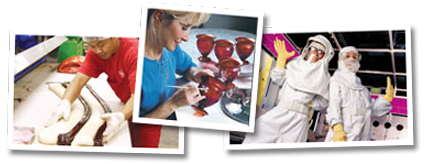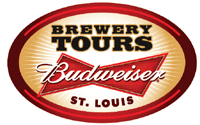
| Anheuser-Busch | BEER |
| 12th and Lynch Streets, St. Louis, MO 63118 | (314) 577-2626 | www.budweisertours.com |
 The tour of the St. Louis brewery (founded 1852), located next to the Anheuser-Busch World Headquarters, puts a face on the world’s largest brewer. As the tour guide leads you from the tour center to the Budweiser Clydesdale paddock and stable, lager cellar, Brew House, Lyon’s Schoolhouse, and Bevo packaging plant, a sense of history and the smell of hops surround you. The Budweiser Clydesdales tradition began in 1933 when August A. Busch Jr. presented his father with the first team of Clydesdales to celebrate the repeal of Prohibition. Today the gentle giants make more than 500 appearances annually with their bright red beer wagon. See where the beer is actually made in the historic six-story Brew House. Built in 1891, the Brew House is a tour favorite with its clock tower, ornate wrought-iron railings, and hop vine chandeliers from the 1904 World’s Fair. The Lyon School House, built in 1868, is the oldest structure in the Anheuser-Busch complex. It served as the company’s headquarters from 1907 until 1981. Visit the beechwood aging and fermentation cellars and Bevo Packaging Plant. Anheuser-Busch is the only major brewer that still uses the famous beechwood aging process to age and naturally carbonate its beers. In the lager cellar, stainless-steel lager tanks are lined with a layer of beechwood chips, providing additional surface area to attract and retain yeast. Beechwood aging is part of the secondary fermentation. Each of the lager tanks holds enough beer to fill approximately 200,000 six-packs. The Bevo Packaging Plant was constructed in 1917 and stands eight stories tall and houses 27 acres of floor space and over 25 miles of conveyor belts. You will see fast-paced action as bottles and cans are filled. Whimsical fox sculptures are perched on each corner of the building, all munching on chicken legs and holding a mug of Bevo, a nonalcohol cereal-based beverage that Anheuser-Busch produced during the Prohibition era. Cost: Free |
|